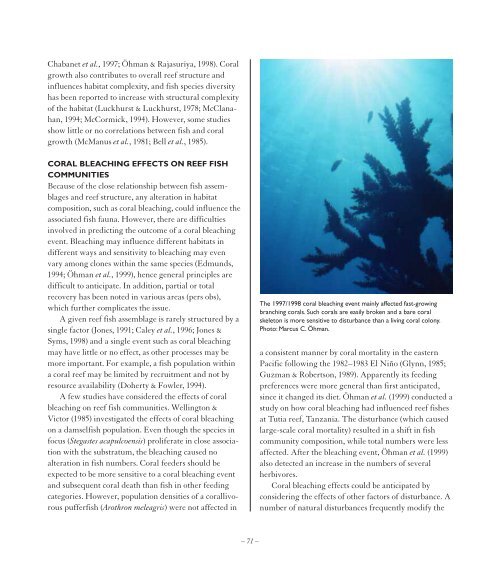You also want an ePaper? Increase the reach of your titles
YUMPU automatically turns print PDFs into web optimized ePapers that Google loves.
Chabanet et al., 1997; Öhman & Rajasuriya, 1998). Coral<br />
growth also contributes to overall reef structure and<br />
influences habitat complexity, and fish species diversity<br />
has been reported to increase with structural complexity<br />
of the habitat (Luckhurst & Luckhurst, 1978; McClanahan,<br />
1994; McCormick, 1994). However, some studies<br />
show little or no correlations between fish and coral<br />
growth (McManus et al., 1981; Bell et al., 1985).<br />
CORAL BLEACHING EFFECTS ON REEF FISH<br />
COMMUNITIES<br />
Because of the close relationship between fish assemblages<br />
and reef structure, any alteration in habitat<br />
composition, such as coral bleaching, could influence the<br />
associated fish fauna. However, there are difficulties<br />
involved in predicting the outcome of a coral bleaching<br />
event. Bleaching may influence different habitats in<br />
different ways and sensitivity to bleaching may even<br />
vary among clones within the same species (Edmunds,<br />
1994; Öhman et al., 1999), hence general principles are<br />
difficult to anticipate. In addition, partial or total<br />
recovery has been noted in various areas (pers obs),<br />
which further complicates the issue.<br />
A given reef fish assemblage is rarely structured by a<br />
single factor (Jones, 1991; Caley et al., 1996; Jones &<br />
Syms, 1998) and a single event such as coral bleaching<br />
may have little or no effect, as other processes may be<br />
more important. For example, a fish population within<br />
a coral reef may be limited by recruitment and not by<br />
resource availability (Doherty & Fowler, 1994).<br />
A few studies have considered the effects of coral<br />
bleaching on reef fish communities. Wellington &<br />
Victor (1985) investigated the effects of coral bleaching<br />
on a damselfish population. Even though the species in<br />
focus (Stegastes acapulcoensis) proliferate in close association<br />
with the substratum, the bleaching caused no<br />
alteration in fish numbers. Coral feeders should be<br />
expected to be more sensitive to a coral bleaching event<br />
and subsequent coral death than fish in other feeding<br />
categories. However, population densities of a corallivorous<br />
pufferfish (Arothron meleagris) were not affected in<br />
The 1997/1998 coral bleaching event mainly affected fast-growing<br />
branching corals. Such corals are easily broken and a bare coral<br />
skeleton is more sensitive to disturbance than a living coral colony.<br />
Photo: Marcus C. Öhman.<br />
a consistent manner by coral mortality in the eastern<br />
Pacific following the 1982–1983 El Niño (Glynn, 1985;<br />
Guzman & Robertson, 1989). Apparently its feeding<br />
preferences were more general than first anticipated,<br />
since it changed its diet. Öhman et al. (1999) conducted a<br />
study on how coral bleaching had influenced reef fishes<br />
at Tutia reef, Tanzania. The disturbance (which caused<br />
large-scale coral mortality) resulted in a shift in fish<br />
community composition, while total numbers were less<br />
affected. After the bleaching event, Öhman et al. (1999)<br />
also detected an increase in the numbers of several<br />
herbivores.<br />
Coral bleaching effects could be anticipated by<br />
considering the effects of other factors of disturbance. A<br />
number of natural disturbances frequently modify the<br />
– 71 –


















